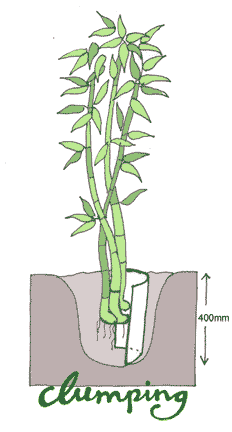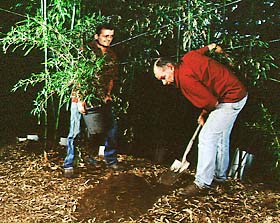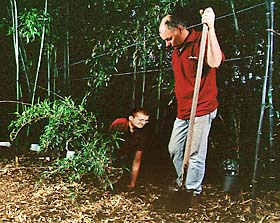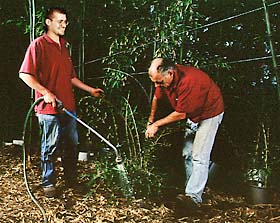Planting bamboo in the ground – needs a little planning
To grow a Running type bamboo, please review our ‘escape proof’ bamboo page.
Right here we focus on Clumping bamboo.
Some species stay quite small, others get really big. Let’s separate them into small, medium and large.
Small Clumping Bamboo (1 – 2 metres)
These need no help to stay where you plant them.

Medium Clumping Bamboo (3 – 8 metres tall)
To isolate the bamboo say, from a boundary or pathway, position HDPE Rhizome Barrier, hard up against the bamboo.
1. Dig planting hole and position bamboo as far from boundary as suitable.
2. Position barrier next to bamboo.
3. Backfill.
Medium clumpers can form a clump 1.5 metres (5′) across after a few years. Manage the clump at this time by removing the old culms (with a set of lopers or a reciprocating saw), Clean out the old growth in the centre which is where it all started. And around the edges as required.
Large Clumping Bamboo (12 metres plus)
The large clumping species are very strong underground. The rhizome can crack a brick wall. So, don’t plant any closer than 2 metres (6′), to a masonry structure.
HDPE Rhizome Barrier (600 mm deep), positioned right next to the bamboo can restrict its growth. Even so, don’t plant closer than 1.5 metre (5′), to masonry footings.
Reinforced concrete, 60 mm (2 1/4″) minimum thick, is the way to isolate large clumping bamboo.
Narrow planter beds.
Used for Clumping (non-invasive) bamboo
Around 150mm wide planter setup is ok for small clumping bamboo such as Stripestem Fernleaf. For Alphonse Karr, 300mm wide planter will work, provided there is adequate length say 900mm minimum, for root growth. Slender Weavers too needs a minimum of 300mm width of planter. Minimum length of planter should also be around 900mm.
Line inside the planter with drainage cell. Use the shallowest cell depth available, around 20mm, cover with geotextile fabric which should line the entire inside of the planter.
Drainage cell also keeps the bamboo rhizome and stems free from the edge of your planter providing ease of maintenance and a more even distribution of outward pressure from the growing bamboo. |
The drainage cell gives you neatness as well as improved drainage.
The growing medium need only be 300 – 350 mm deep. Use a premium grade potting mix. Top dressing with 50 mm compost is a good way to start off your new planting. In any case add some fertilizer.
Now, planting bamboo in three steps Get your hands dirty
Step 1
Think about drainage
Poor drainage can kill bamboo
Instead of planting into clay or hard soil, make a mound, (as deep as your pot is) of good soil mixed with compost. Then plant your bamboo on top of the existing soil (remove vegetation first). Secure the bamboo with stakes if is big enough to be blown over. After it has become established it will grow into the clay and access those minerals.
Be attentive.
Keep roots and leaves moist, and shade your bamboo. Especially on hot days, windy days. If it must be waiting in the sun for you, stand it up to prevent the culms from overheating. This happens quickly.
Still thinking
Nearby plants will compete with your new bamboo. They pump water from the soil. Think about incorporating a water retainer to give your baby the edge.
Step 2
NOW, dig a hole bigger than the bamboo root ball.

Mix in a cup of dolomite this will attract worms, plus a few inches of your good soil/compost.

Gently place the bamboo in the hole. Plant a little deeper than the surrounding soil, this will support the plant a bit more.

Step 3
Finish it right
Back-fill with friable soil, add some little compost but don’t include soluble fertiliser or manure because it may burn the roots.
When backfilling the point is to minimise air pockets, the root ball should be in intimate contact with the surrounding soil. Carefully tamp in the soil taking care not to damage roots or buds.
While tamping hose add water to form a slurry. That’ll fill the voids. Now you can top dress with fertiliser, compost and other organic goodies. Form a trench in the new soil right around the bamboo, to contain water. Water in well. And also the next day.
Remember. The root-ball needs time to grow roots out into the surrounding soil – to become established. For the first few months ensure that it’s the original root-ball that gets most water.
Not finished yet my son
Mulch around the plant to retain moisture and suppress weeds. In windy conditions or where the new plant can be knocked, support it with stakes either side and link with twine.
Bamboo loves organic fertiliser (don’t we all). However, organics don’t have much potassium and bamboo needs it, so an occasional dressing with a complete fertiliser will provide this element. Fertiliser for bamboo: N:10. P:5. K:5. Add trace elements once a year.
Let me expand on the magic of mulch
Bare soil dries out quickly. That same soil covered with 100 mm of mulch maintains its moisture.Worms crawl about on what once was the surface and is now dark and cool and under colonization by millions of beneficial organisms. Plant roots can come right into the mulch, breaking it down. Soon fallen bamboo leaves will create a self renewing soil.
You can go now.
Absolutely Mr Bamboo can install bamboo in-ground for you. On boundaries we use Rhizome Barrier to keep it precisely in place.